|
|
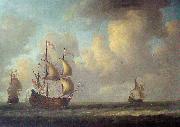 |
Jeronymus van Diest
|
|
(1631, The Hague - ca.1687, The Hague), was a Dutch Golden Age seascape painter.
According to Houbraken, a Jeronymus van Diest was good with grisailles and was the teacher of Adriaen van de Venne.[1] This grisaille painter Jeronymus Diest (I) may possibly have been a grandfather of the younger Jeronymus Diest (II); since they are both from the Hague.
According to the RKD this younger Jeronymus Diest (II) was the son of the painter Willem van Diest and the father of the painter Adriaen van Diest who was a follower of Jan van Goyen and Hendrik Dubbels.His known works are all seascapes with various ships at sail. |
|
|
|
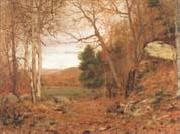 |
Jervis Mcentee
|
|
American Realist Painter, 1828-1891, He was an American painter of the Hudson River School. He is a somewhat lesser-known figure of the 19th century American art world, but was the close friend and traveling companion of several of the important Hudson River School artists. Aside from his paintings, McEntee's enduring legacy are the detailed journals he kept from the early 1870s until his death. In his writings McEntee records a detailed account of Hudson River School artists, their day-to-day life, gossip and personal reflections, and the overall arc of the American art world in the second half of the 19th century. He discusses his artistic successes and trials, particularly as money becomes more scarce with the decline in popularity of Hudson River School art. McEntee's journals are now kept by the Archives of American Art, a research center within the Smithsonian Institution. Five volumes of these diaries, from 1872 to 1890, have been digitally scanned, transcribed, and can be browsed in their entirety in the Jervis McEntee Diaries Online. McEntee was born in Rondout, New York on July 14, 1828. Little is known of his childhood. He exhibited his first painting at the National Academy of Design in New York City in 1850. |
|
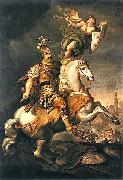 |
Jerzy Siemiginowski-Eleuter
|
|
(ca. 1660 - ca. 1711) was a prominent Polish painter and engraver of the Baroque, court painter of king John III Sobieski and a Polish-Lithuanian noble. He is considered one of the most accomplished painters of Classical Baroque in Poland, who joined in his works classical theory with genuine motives.
|
|
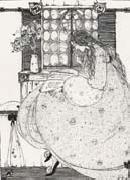 |
Jessie Marion King
|
|
1875-1949,was a Scottish painter and illustrator of Children's books. She was married to E. A. Taylor. She was born in Bearsden, near Glasgow. Her father was a minister with the Church of Scotland and she received a strict religious education and was discouraged from becoming an artist. Jessie M. King began training as an Art teacher in 1891 at Queen Margaret??s College. In 1892 she entered the Glasgow School of Art. As a student, she received a number of awards, including her first silver medal from the National Competition, South Kensington (1898). King was made Tutor in Book Decoration and Design at Glasgow School of Art in 1899. Her first published designs, and some people believe her finest, were for the covers of books published by Globus Verlag, Berlin between 1899 and 1902. The publisher was a subsidiary company of the great Berlin department store, Wertheim's. She was influenced by the Art Nouveau of the period and her works juxtaposed in mood with that of The Glasgow Four. She made a Grand Tour of Germany and Italy in 1902 and was influenced by the works of Botticelli. In the same year her binding for "L'Evangile de L'Enfance" was awarded a gold medal in the International Exhibition of Modern Decorative Art, held in Turin. King became a committee member of the Glasgow Society of Artists (1903) and a member of the Glasgow Society of Lady Artists (1905). Her contribution to Art Nouveau peaked during her first exhibitions, Annan's Gallery in Glasgow (1907) and Bruton Street Galleries, London (1905). She married E. A. Taylor in 1907 and moved with him to Salford. In 1910 they moved on to Paris where Taylor had gained a professorship at Tudor Hart's Studios. |
|
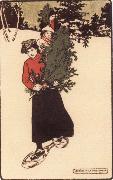 |
Jessie Willcox Smith
|
|
American Golden Age Illustrator, 1863-1935
was an American illustrator famous for her work in magazines such as Ladies Home Journal and for her illustrations for children's books. Born in the Mount Airy neighborhood of Philadelphia, Pennsylvania, Smith studied at the Pennsylvania Academy of the Fine Arts under Thomas Eakins in Philadelphia, graduating in 1888. A year later, she started working in the production department of the Ladies Home Journal, for five years. She left to take classes under Howard Pyle, first at Drexel and then at the Brandywine School. Jessie Willcox Smith, Illustration for The Water-Babies (1916)She was a prolific contributor to books and magazines during the late nineteenth and early twentieth centuries, illustrating stories and articles for clients such as Century, Collier's Weekly, Leslie's Weekly, Harper's, McClure's, Scribners, and the Ladies' Home Journal. Smith may be most well known for her covers on Good Housekeeping, which she painted from December 1917 through March 1933. She also painted posters and portraits. Her twelve illustrations for Charles Kingsley's The Water Babies (1916) are also well known. On Smith's death, she bequeathed the original works to the Library of Congress' "Cabinet of American Illustration" collection. Smith was close friends with the artists Elizabeth Shippen Green and Violet Oakley, |
|
|
|
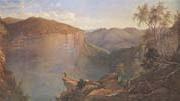 |
JH Carse
|
|
Australian Painter, ca.1819-1900 |
|
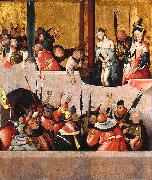 |
Jheronimus Bosch
|
|
c. 1450 - 9 August 1516), was a Dutch painter. His work is known for its use of fantastic imagery to illustrate moral and religious concepts and narratives.
Hieronymus Bosch was born Hieronymus (or Jeroen, respectively the Latin and Middle Dutch form of the name "Jerome") van Aken (meaning "from Aachen"). He signed a number of his paintings as Bosch (pronounced Boss in Middle Dutch). The name derives from his birthplace, 's-Hertogenbosch, which is commonly called "Den Bosch".
Little is known of Bosches life or training. He left behind no letters or diaries, and what has been identified has been taken from brief references to him in the municipal records of 's-Hertogenbosch, and in the account books of the local order of the Brotherhood of Our Lady. Nothing is known of his personality or his thoughts on the meaning of his art. Bosches date of birth has not been determined with certainty. It is estimated at c. 1450 on the basis of a hand drawn portrait (which may be a self-portrait) made shortly before his death in 1516. The drawing shows the artist at an advanced age, probably in his late sixties
|
|
|
|
|
|
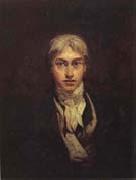 |
Jmw Turner
|
|
1775-1851
British landscape painter. The son of a barber, he entered the Royal Academy school in 1789. In 1802 he became a full academician and in 1807 was appointed professor of perspective. His early work was concerned with accurate depictions of places, but he soon learned from Richard Wilson to take a more poetic and imaginative approach. The Shipwreck (1805) shows his new emphasis on luminosity, atmosphere, and Romantic, dramatic subjects. After a trip to Italy in 1819, his colour became purer and more prismatic, with a general heightening of key. In later paintings, such as Sunrise, with a Boat Between Headlands (1845), architectural and natural details are sacrificed to effects of colour and light, with only the barest indication of mass. His compositions became more fluid, suggesting movement and space. In breaking down conventional formulas of representation, he anticipated French Impressionism. His immense reputation in the 19th century was due largely to John Ruskin's enthusiasm for his early works |
|
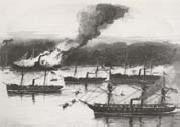 |
Jo Davidson
|
|
American Sculptor, 1883-1952,was an American sculptor of Russian-Jewish descent. Although he specialized in realistic, intense portrait busts, Davidson did not require his subjects to formally pose for him; rather, he observed and spoke with them. He worked primarily with clay, while the final products were typically cast in terra-cotta, marble and bronze. Born in New York City, Davidson attended Yale University before moving to Paris to study sculpture at Ecole nationale superieure des beaux arts in 1907. After returning to the United States, he was befriended by Gertrude Vanderbilt Whitney, who purchased some of Davidson's work. In 1911 Davidson secured his first solo gallery shows; in 1934 he won the National Academy of Design Maynard Prize, and in 1947 the American Academy of Arts and Letters hosted a retrospective featuring nearly 200 of his works. He was one of 250 sculptors who exhibited in the 3rd Sculpture International held at the Philadelphia Museum of Art in the summer of 1949. Among Davidson commissions are a design for a United States War Industries badge, a collection of pieces for the Government of France to commemorate the first victory of the Troupes de Marine and bronze busts of the leaders of the Allies. His portraits of world leaders and celebrated personalities gained him international acclaim, and included such luminaries as Woodrow Wilson, Franklin Delano Roosevelt, Rudyard Kipling, James Joyce, Gertrude Stein, Andrew Mellon, Will Rogers, John D. Rockefeller, Joseph Conrad, Anatole France, Lincoln Steffens, Gertrude Vanderbilt Whitney, Marshall Ferdinand Foch, General John J. Pershing, John Marin, Rabindranath Tagore, Frank Harris, Israel Zangwill, Charlie Chaplin, Robert M. La Follette, Clarence Darrow, Emile Coue (who was also a sculptor in his spare time), H. G. Wells, Robinson Jeffers, Andre Gide. George Bernard Shaw, James Barrie, Arthur Conan Doyle,D. H. Lawrence, W. Averell Harriman, Madame Chiang Kai shek, Dolores Ibarruri, aka La Passionaria, Helen Keller, Mahatma Gandhi, Dwight D. Eisenhower, Ida Rubinstein, Albert Einstein, Carl Sandburg, Marshall Tito, E. W. Marland and Walt Whitman. Will Rogers statue is a full-body bronze portrait erected at the United States Capitol in 1939. Walt Whitman portrait is also a full-body bronze, and stands in Bear Mountain State Park, New York. Some of Davidson's work is in the National Gallery of Art and in the Capitol Building where he has placed two works, Will Rogers of Oklahoma and Robert M. La Follette of Wisconsin in the National Statuary Hall, and busts of two vice presidents, Henry A. Wallace and Charles G. Dawes, all of which are located in Washington, D.C.. He also designed a statue of Henry D. Thoreau, the author of WALDEN. The statue is located at Walden Pond State Reservation in Concord, MA. In 2006, The Smithsonian Institution's National Portrait Gallery opened a permanent exhibition, Jo Davidson: Biographer in Bronze, showcasing fourteen Davidson works in terracotta and bronze, including portraits of Gertrude Stein and Lincoln Steffens. |
|
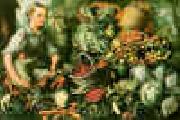 |
Joachim Beuckelaer
|
|
1535-1574
Flemish
Joachim Beuckelaer Galleries
b Antwerp, c. 1534; dAntwerp, c. 1574). Flemish painter. He came from an Antwerp family of obscure painters and seems to have spent his entire life there. He trained in the studio of Pieter Aertsen, who in 1542 had married Beuckelaers aunt; he became an independent master and also married in 1560. His earliest known work dates from that year, and his development can be followed closely to 1570. The example of Beuckelaers master remained decisive throughout his career. Not only did he take over Aertsens new repertory of secular subjects, he also completely adopted his stylistic idiom and manner of painting, so that it can be difficult to distinguish the two hands. Beuckelaer was, however, by no means a slavish imitator, and as regards execution he fully bears comparison with Aertsen. |
|
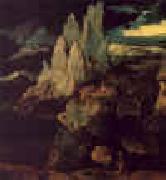 |
Joachim Patenier
|
|
1480-1525
Flemish
Joachim Patenier Galleries
was a Flemish Northern Renaissance history and landscape painter. He was probably the uncle of Herri met de Bles, with whom he helped establish a distinct style of northern Renaissance landscapes. |
|
|
|
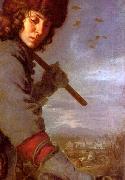 |
Joachim von Sandrart
|
|
(12 May 1606 - 14 October 1688) was a German Baroque art-historian and painter, active in Amsterdam during the Dutch Golden Age.
Sandrart was born in Frankfurt, but the family originated from Mons. According to Houbraken (who used his Teutsche Akademie as a primary source), he learned to read and write from the son of Theodor de Bry, Johann Theodoor de Brie and his associate Matthäus Merian, but at age 15 was so eager to learn more of the art of engraving, that he walked from Frankfurt to Prague to become a pupil of Gillis Sadelaar (also known as Aegidius Sadeler of the Sadeler family). Sadelaar in turn urged him to paint, whereupon he travelled to Utrecht in 1625 to become a pupil of Gerrit van Honthorst, and through him he met Rubens when he brought a visit to Honthorst in 1627, to recruit him for collaboration on part of his Marie de' Medici cycle. Honthorst took Sandrart along with him when he travelled to London. There he worked with Honthorst and spent time making copies of Holbein portraits for the portrait gallery of Henry Howard, 22nd Earl of Arundel.
Making all of those copies only served to arouse more curiosity in the young adventurer, and in 1627 Sandrart booked a passage on a ship from London to Venice, where he was welcomed by Jan Lis (whose Bentvueghels bent name was "Pan"), and Nicolaas Ringnerus. He then set out for Bologna, where he was met by his cousin on his father's side Michael le Blond, a celebrated engraver. With him, he crossed the mountains to Florence, and from there on to Rome, where they met Pieter van Laer (whose bent name was "Bamboccio"). Sandrart became famous as a portrait-painter. After a few years he undertook a tour of Italy, traveling to Naples, where he drew studies of Mount Vesuvius, believed to be the entrance to the Elysian fields described by Virgil. From there he traveled to Malta and beyond, searching for literary sights to see and paint, and wherever he went he paid his way by selling portraits. Only when he was done traveling did he finally return to Frankfurt, where he married Johanna de Milkau.
Afraid of political unrest and plague, he moved to Amsterdam with his wife in 1637.
|
|
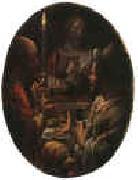 |
Joachim Wtewael
|
|
1566-1638 Flemish Joachim Wtewael Galleries
Dutch painter and draughtsman. He was one of the last exponents of MANNERISM. From c. 1590 until 1628, the year of his latest known dated paintings, he employed such typical Mannerist formal devices as brilliant decorative colour, contrived spatial design and contorted poses. He sometimes combined such artifice with naturalism, and this amalgam represents the two approaches Dutch 16th- and 17th-century theorists discussed as uyt den geest (from the imagination) and naer t leven (after life). Wtewaels activity reflects the transition from Mannerism to a more naturalistic style in Dutch art. Slightly over 100 of his paintings and about 80 drawings are known. Subjects from the Bible and mythology predominate; he also painted several portraits, including a Self-portrait (1601; Utrecht, Cent. Mus.). |
|
|
|
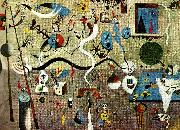 |
joan miro
|
|
Joan Mir?? i Ferr?? (April 20, 1893 ?C December 25, 1983; Catalan pronunciation: was a Catalan Spanish painter, sculptor, and ceramist born in Barcelona.
Earning international acclaim, his work has been interpreted as Surrealism, a sandbox for the subconscious mind, a re-creation of the childlike, and a manifestation of Catalan pride. In numerous interviews dating from the 1930s onwards, Miro expressed contempt for conventional painting methods as a way of supporting bourgeois society, and famously declared an "assassination of painting" in favour of upsetting the visual elements of established painting. |
|
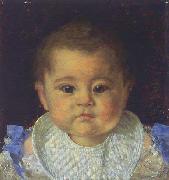 |
Joanna Mary Boyce
|
|
Joanna Mary Boyce, also known as Mrs. H. T. Wells, her married name, (7 December 1831 - 15 July 1861) was an English painter of portraits, genre pictures, and occasionally landscapes. She was the sister of pre-Raphaelite watercolorist George Price Boyce, and was herself associated with the Brotherhood.
|
|
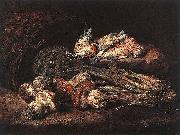 |
Joannes Fijt
|
|
(15 March 1611 - 11 September 1661) was a Flemish Baroque animal painter and etcher.
Fyt was born in Antwerp, where he was baptized on 15 June 1611, he was registered in 1621 as apprentice to Hans van den Berghe, who was a restorer of old pictures rather than a painter of new ones. Fyt then trained with Frans Snyders between about 1629-31, during which time, at the age of twenty, he entered the guild of St Luke as a master. From then until his death in 1661, he produced a vast number of paintings in which the bold facility of Frans Snyders is united to the powerful effects of Rembrandt, and harmonies of gorgeous tone are not less conspicuous than freedom of touch and a true semblance of nature.
He left Antwerp for Paris in 1633, travelling on to Italy the following year, where he worked in Venice and probably visited Rome (as he later joined the Guild of Romanists back in Antwerp). By 1641 he was back in Antwerp, where he married in 1654.
Hunting trophiesFyt excelled in the rendering of animal life in its most varied forms. He may have been less correct in outline, less bold in action than Snyders, but he was much more skilful and more true in the reproduction of the coat of deer, dogs, greyhounds, hares and monkeys, whilst in realizing the plumage of peacocks, woodcocks, ducks, hawks, and cocks and hens, he had no equal, nor was any artist even of the Dutch school more effective in relieving his compositions with accessories of tinted cloth, porcelain ware, vases and fruit.
He was not clever at figures, and he sometimes trusted for these to the co-operation of Cornelius Schut or Thomas Willeboirts Bosschaert, whilst his architectural backgrounds were sometimes executed by Quellyn. Silenus amongst Fruit and Flowers, in the Harrach collection at Vienna, Diana and her Nymphs with the Produce of the Chase, in the Belvedere at Vienna, and Dead Game and Fruit in front of a Triumphal Arch, belonging to Baron von Rothschild at Vienna, are specimens of the co-operation respectively of Schut, Willeborts and Quellyn. They are also Fyt's masterpieces. The earliest dated work of the master is a cat grabbing at a piece of dead poultry near a hare and birds, belonging to Baron Cetto at Munich, and executed in 1644. The latest is a Dead Snipe with Ducks, of 1660, sold with the Jäger collection at Cologne in 1871.
Great power is shown in the bear and boar hunts at Munich and Ravensworth castle. A Hunted Roedeer with Dogs in the Water, in the Berlin Museum, has some of the life and more of the roughness of Snyders, but lacks variety of tint and finish. A splendid specimen is the Page and Parrot near a table covered with game, guarded by a dog staring at a monkey, in the Wallace collection. With the needle and the brush Fyt was equally clever. He etched 16 plates, and those representing dogs are of their kind unique.
|
|
|
|
|
|
|
|
|
|
|
|
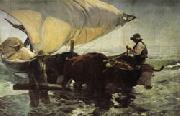 |
Joaquin Sorolla Y Bastida
|
|
Spanish Realist/Impressionist Painter , 1863-1923
Spanish painter, b. Valencia. He is noted for his large landscapes in full, glowing sunlight, painted in strong color and in a bold, fluent style. Sorolla's best-known works include Beaching the Boat and The Swimmers. |
|
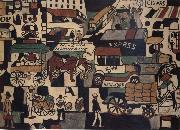 |
Joaquin Torres-Garcia
|
|
Uruguayan Painter and Sculptor, 1874-1949,was a Uruguayan artist (in a variety of media) and art theorist, also known as the founder of Constructive Universalism. Born in Montevideo, Torres Garcia later travelled extensively, and lived for some time in Barcelona, New York, Paris, and Madrid. He returned to Uruguay in 1934. |
|
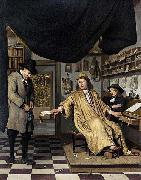 |
Job Adriaenszoon Berckheyde
|
|
(27 January 1630 - 10 June 1698) was a Dutch artist of the 17th century, active in Haarlem, Amsterdam, and The Hague.
Job Berckheyde was born in Haarlem and was the older brother of the painter Gerrit who he later taught to paint. He was apprenticed on 2 November 1644 to Jacob Willemszoon de Wet, and his master's influence is apparent in his first dated canvas, "Christ Preaching to the Children" (1661), one of his few biblical scenes. On 10 June 1653 he repaid a loan from the Haarlem Guild of Saint Luke. From 1656-1660 the two brothers made an extended trip along the Rhine to Germany, stopping off at Cologne, Bonn, Mannheim and finally Heidelberg, following the example of their fellow guild member Vincent van der Vinne. The brothers worked in Heidelberg for Charles I Louis, Elector Palatine (with Job producing portraits and hunting scenes, and receiving a gold chain from the Elector in reward) but were ultimately unable to adapt to court life and so returned to Haarlem, where they shared a house and perhaps a studio. He became a member of the Haarlem rederijkersgilde 'De Wijngaardranken' in 1666-1682. He is registered in Amsterdam 1682-1688, where he became a member of the Guild of St Luke there in 1685-1688.Berckheyde was buried in Haarlem. |
|
|
|
|
|
|
|
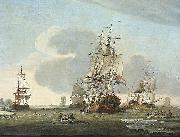 |
Jochem de Vries
|
|
painted The Zaandam shipping company Claes Tan en Zns Greenland farer Zaandam whaling in 1772
|
|
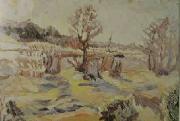 |
Joel Pettersson
|
|
(June 8, 1892 - January 5, 1937) was a painter and writer on the Åland Islands, Finland. He remained an obscure figure during his lifetime; most of his works were unpublished for decades after his death.
Pettersson was born into poverty in Lemland, Åland. His parents were elderly peasants, Joel's father being well over 50 at the time of Joel's birth. Joel had a younger brother Karl, who died at sea in 1916.
Pettersson began writing and painting in his early school years, though much of his works from this period were not preserved.
In 1913, he had the opportunity to study at a drawing school in Turku. He stayed in Turku until 1915, when he decided to abort his studies and return to Åland. He painted for a few years, but he eventually tired of it and did not paint for many years.
Upon his return, Pettersson became active in the local youth organisation, for which he wrote plays and monologues. He also wrote prose which he read out loud during organisation meetings. Pettersson was most active as a writer following his return from Turku until 1921.
During the 1920s, Pettersson worked mostly on his parents' farm, only sporadically participating in the youth organisation's activities. His parents both died in 1928, leaving Pettersson to care for the farm. He sold all the animals and most of the property. He tried earning a living on his artistry, but was unsuccessful. He then tried raising hens, but this also proved to be an unsuccessful venture. He resumed painting in 1935, and some of his paintings were displayed during an exhibition the following year.
His constant economic difficulties and work load took their toll. In 1936, he suffered a nervous breakdown and was committed to Grelsby Asylum, where he remained until his death in early 1937. |
|
|
|
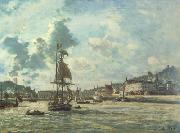 |
Johan Barthold Jongkind
|
|
Dutch Impressionist Painter, 1819-1891
was a Dutch painter and printmaker regarded as a forerunner of Impressionism who influenced Claude Monet. Jongkind was born in the town of Lattrop in the Overijssel province of the Netherlands near the border with Germany. Trained at the art academy in The Hague, in 1846 he moved to the Montmartre quarter of Paris, France where he studied under Eugene Isabey and Francois-Edouard Picot. Two years later, the Paris Salon accepted his work for its exhibition, and he received acclaim from critic Charles Baudelaire and later on from Emile Zola. Jongkind was to experience little success, however, and he suffered bouts of depression complicated by alcoholism. Jongkind returned to live in Rotterdam in 1855, and remained there until 1860. Back in Paris, in 1861 he rented a studio on the rue de Chevreuse in Montparnasse where some of his paintings began to show glimpses of the Impressionist style to come. In 1862 he befriended the young Claude Monet who later referred to Jongkind as the "master." The following year Jongkind exhibited at the first Salon des Refus's. Despite several successes, in another of his down periods the Impressionist group did not accept his work for their first exhibition in 1874. |
|
|
|
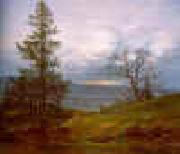 |
Johan Christian Dahl
|
|
1788-1857
Norwegian
1857). Norwegian painter and collector, active in Germany. His paintings, imbued with Romantic and patriotic sentiments, had a strong influence on the landscape tradition both in Germany (especially Dresden) and in his native Norway. |
|
 |
Johan Christoffer Boklund
|
|
(15 July 1817 - 9 December 1880) was a Swedish history, genre, and portrait painter from Kulla-Gunnarstorp in Scania.He was the son of a gardener. At the age of fifteen, Boklund came to Lund, where he worked on illustrations for Sven Nilsson's works on Scandinavian fauna (under the supervision of Magnus Körner). He then became a student at the Royal Danish Academy of Fine Arts in Copenhagen where J. L. Lund was his teacher.
In 1837, Boklund went to Stockholm and began studying at the Royal Swedish Academy of Arts. He made a living as a lithograph and drawing teacher, and produced several small genre paintings of the everyday life (such as Flicka med blomster (English: Girl with flowers) and Köksinteriör (English: Kitchen interior)) and history paintings of the 17th century (such as Gustaf Adolfs afsked från Maria Eleonora (English: Gustaf Adolf's farewell from Maria Eleonora), which was awarded with a medal at the academy).
Together with fellow Swedish painter Johan Fredrik Höckert, Boklund traveled to Munich in Germany in 1846 and stayed there for eight years. During the summers he went on study trips to Bavaria, Tyrol, and northern Italy. During this period, Boklund primarily devoted his painting to the history genre with subjects from the 17th century, but he also made some paintings depicting picturesque and architectural interior. In 1853, he sent his painting Den nyfikne trumpetaren (English: The curious trumpet player) home to Sweden and it earned him a scholarship from the government. This allowed Boklund to move to Paris, where he worked at Thomas Couture's atelier from 1854 to 1855. In December 1855 he returned to Sweden. |
|
|
|
|
|
|
|
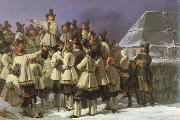 |
johan gustaf sandberg
|
|
Johan Gustaf Sandberg, född 1782, död 1854, var målare; han var professor i teckning vid Konstakademien från 1828, och direktör där 1845?C1853.
Sandberg ägnade sig främst åt historiemåleri, med motiv ur nordisk mytologi och svensk historia. Hans främsta verk inom detta område är kalkmålningarna över Gustav Vasa i Uppsala domkyrka. Han målade också en mängd porträtt.
Sandberg blev 1794 elev i konstakademins principskola och 1801 i antikskolan, lärde samtidigt musik och klaverspelning och tjänade pengar genom lektioner och genom arbete på kungliga teaterns dekorationsmålarverkstad. Under den följande tiden slöt han sig till den opposition mot akademin, som hade sin medelpunkt i "Sällskapet för konststudium". Tvisten med akademin lade sig snart, Sandberg valdes till ledamot 1821 och blev ordinarie professor 1828. Däremot hade han aldrig tillfälle att göra den för äldre tiders konstnärer obligatoriska studieresan till södern.
Han utförde teckningarna till praktverket "Ett år i Sverige" (1827 -35) med bilderna graverade under Christian Didrik Forssells ledning och texten skriven av Anders Abraham Grafström. Under upprepade sommarvistelser på Säfstaholms slott målade Sandberg folktyper och folkdräkter.
Åtskilliga porträtt utförde Sandberg för det praktfulla "Galleri af utmärkta svenska lärde, vetenskapsidkare och konstnärer", som han utgav 1835?C42 (100 porträtt, litograferade av J. Cardon).
|
|
|
|
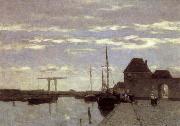 |
Johan Hendrik Weissenbruch
|
|
Dutch Painter, 1824-1903
Painter, cousin of Jan Weissenbruch. He referred to himself and signed his work as Jan Hendrik Weissenbruch. From 1840 he attended drawing lessons with the Norwegian painter Johannes Lew, and from 1846 he was taught by Bartholomeus J. van Hove at the Koninklijke Academie van Beeldende Kunsten in The Hague. His early paintings clearly show the influence of van Hove and Andreas Schelfhout, although it is uncertain whether he was actually taught by the latter. His father, an avid collector, owned works by both artists. |
|
|
|
 |
johan krouthen
|
|
född 2 november 1858, död i december 1932, var en svensk idealistisk konstnär.
Krouthen föddes i Linköping och var son till handlaren Conrad Krouthen och Hilda Åberg. Släkten Krouthen kom från Norrköping och flera generationer hade arbetat som tenngjutare. Familjenamnet Krut ändrades genom att varubeteckningen Krut-tenn förfranskades till Krouthen. Conrad Krouthen kom till Linköping 1850 och startade en manufakturaffär vid Stora torget. Affären gick bra och 1857 kunde han gifta sig med sömmerskan Hilda Åberg.
Krouthen kunde växa upp i ett välmående hem och han fick börja skolan på läroverket i Linköping. Vid 14 års ålder slutade han skolan och började arbeta åt fotografen och målaren Svante Leonard Rydholm som hade en atelje vid St. Larsplan. Krouthen fick lära sig grunderna i både målning och fotografering och vid 16 års ålder började han på Konstakademiens principskola i Stockholm 1875. Den treåriga utbildningen innebar att eleverna fick lära sig att rita av klot och profiler, djur och växter. Efter de tre åren fick Krouthen fortsätta vid akademin. I kursen "Lägre antiken" fick eleverna rita av gipsmodeller, i "Högre antiken" teckna efter levande model och i "Landskapsskolan" fick eleverna måla landskap. Under studietiden sökte sig många elever utanför skolan och Krouthen lärde känna konstnären Edvard Perseus. Perseus var kritisk till utbildningen på akademin och tog med sina elever bland annat till Mariefred och Gripsholms slott för att måla av naturen. |
|
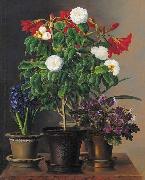 |
Johan Laurentz Jensen
|
|
(8 March 1800, Gentofte - 26 March 1856, Copenhagen) was a Danish artist who specialized in flower painting.
In parallel with his studies at the Danish Academy, he became a pupil of Christoffer Wilhelm Eckersberg and also of Cladius Detlev Fritzsch. Specializing in flower painting, Jensen continued his education in Paris under the Flemish flower painting brothers, Gerard and Cornelis van Spaendonck, and at the porcelain factory in Sevres where he learnt the art of miniature flower painting. Taking 17th-century Dutch flower painting as a starting point, he revived the art in Denmark. His floral arrangements often had both a decorative and symbolic value. Danish plants were often accompanied by exotic flowers and fruits, sometimes even birds. He also became head artist at the Danish Procelain Factory. Jensen had an extensive circle of customers and many students, especially women, including Louise of Hesse-Kassel who later married King Christian IX. Since the 1980s, his works have gained wide international recognition. Many are exhibited in Statens Museum for Kunst and in Thorvaldsens Museum. |
|
|
|
|

